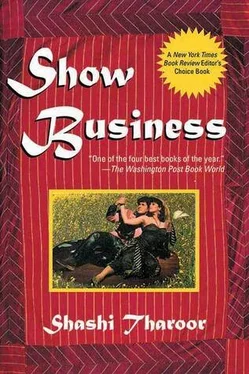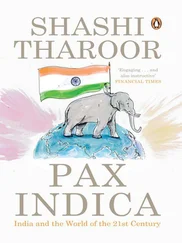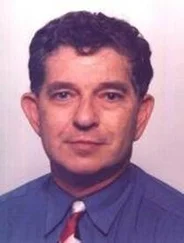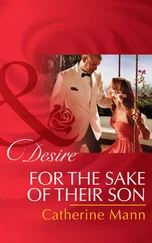It’s not as if I’m being worked to the bone or anything. Any period of film shooting consists of bursts of frenetic activity interspersed with long bouts of hanging around waiting for people to set things up: scenes, lighting, equipment. In one eight-hour shift the director will probably expose anything from one thousand and two hundred to three thousand feet of film, the exact figure depending on how undemanding he is, how competent his crew and cast are, and how many technical things that can go wrong do go wrong. There’s about ninety to ninety-five feet of celluloid to every minute of filmed action, so the most productive crew actually gets about half an hour’s worth of film into the can at the end of an eight-hour shift — and most don’t manage half of that. Of that footage no more than one-fifth actually survives the cutting room floor and is included in the movie itself. Which means that each shift actually contributes something like three to six minutes to the movie people pay to see in the cinema theater.
“Have I shot anything for this film already?” I ask the secretary as I am about to leave. The film’s name means nothing to me, but then most Hindi film names don’t mean anything to anybody.
“Yes, sir,” replies my efficient Subramanyam. “You have done two shootings already, sir, last month. One-and-half shifts.”
“One-and-tf-half, Subramanyam,” I chide him gently. “You don’t know what it’s about, do you?”
Subramanyam looks bashful. “No, sir, I am not knowing.”
“Well, I guess I’ll find out. There’ll be plenty more shifts to catch up with the story.”
As the star, for a big film I’d have to put in anything from twenty to thirty shifts myself. When I’m doing a half dozen films simultaneously, some of them shot in locations far away from the other directors’ studios, “gimme dates” becomes a plaintive cry. I used to think that a movie that took three years to make actually involved people toiling every day for three years. Not a bit of it: all that probably happened was that the producer had too ambitious a cast, and he couldn’t get dates. It’s worst of all when both the hero and the heroine are stars in great demand. The dates he gives may not coincide with hers, and you can’t shoot love scenes on different shifts.
I turn up at Himalaya Studios and am hustled into costume: synthetic sweatshirt, blue baseball cap, unfashionably unfaded jeans and canvas shoes. A dirty white handkerchief is knotted hastily around my neck. I am some sort of local tough, defender of the neighborhood and general all-purpose good guy, who will of course go on to demolish the villains and marry the rich heroine.
“What’s supposed to happen here?” I ask the director, as the makeup man puts on the necessary traces of blush to heighten the rosiness of my cheeks. Nearly thirty years since Independence and we still associate pink skin with healthiness.
“We’re ready to shoot,” he says, trying to sound efficient and in charge. He’s a young fellow, some producer’s son, known to everybody, even me who’s his age, as The Boy.
“Congratulations, but that’s not what I meant,” I reply. “What are we ready to shoot?” I have long since given up looking at scripts. There are too many of them and they all read alike, and in any case it’s too much to keep up with three convoluted plot lines a day.
“Oh. I see what you mean.” The Boy is quick to catch on; it’s clear he knows his profession. “It’s an outdoor shot. Heroine’s car breaks down, some rowdies start bothering her, you tell them to buzz off, bash them up when they don’t, open the hood and fix the car. Simple.”
“Straightforward,” I agree. “Any deathless dialogue in this one, or can I make it up as I go along?”
The director looks dubious. There are directors here who make movies without scripts, contenting themselves with story lines on ever-changing scraps of paper, but The Boy is not confident enough for that. He tries to be flexible. “Just the line when you first tell them to buzz off — there’s some good stuff in there, I think. Something about haven’t they got mothers and sisters. The rest you can ad-lib.”
“Good.” The makeup man is finished. “Lead me to it.”
There is only one outdoor locale at Himalaya, which is not small as Bombay studios go. This is a street that runs past the studio’s administration office and canteen into a clump of bushes and flowering trees that could serve, if shot from the right angles, as a low-budget setting for romantic rural interludes. A red Fiat is already parked on the street, and there seems to be a girl in it, though from where I am approaching, most of her face is obscured by a large straw hat. As I step out into the street a ragged cheer goes up from the throng of hangers-on who always seem to manage to get onto the studio grounds. I wave grandly back at them, taking care not to walk close enough to be touched or importuned for autographs.
The director walks up with a closely typed page from the screenplay containing the dialogue he wants me to remember. I dismiss the proferred sheet. “Read it to me,” I say. The makeup man, a fat dark chap with a front pocket full of combs and brushes, hovers around, examining me critically in the bright sunlight. The mirror in his hand catches the light and reflects it into my eye as I am listening to The Boy, so I shoo him away with a gesture of irritation. He backs off but continues to examine me from a safer distance, the mirror turned away from my eyes.
The rowdies, in tight-fitting T-shirts and corduroy pants, mill about the car, trying to chat up the straw hat. The inevitable Arriflex camera (every Indian cinematographer uses Arriflex, as if they’ve never heard of any other brand) stands on a steel tripod, pointing at them. The electrical equipment is now in place, principally a blue wooden box the size of a car battery (for all I know it might well have been a car battery in an earlier incarnation), capped by three fuse boxes and sporting an array of sockets on the side from which sprout a tangle of wires of every color. The technicians, dark dusty men wearing dirty chappals and checked shirts that hang out of their trousers, are sitting around on makeshift wooden stools, waiting for me. Let them wait.
They’re not the only ones. In one cluster of folding chairs on the other side of the street sit unknown stalwarts of the production team, chatting, reading Hindi newspapers, drinking tea, seemingly disengaged from the day’s events. God knows who they are, or what their role is. Every unit I’ve seen seems to have some fifty people on its payroll at each shift, about twenty of whom are completely idle at any given time. My old friend Tool Dwivedi would have liked nothing better than to be one of them.
I’ve absorbed the mothers and sisters bit in the dialogue. “Got it,” I confirm.
“Ready for action?” The Boy asks.
“Sure. But you’re not.” I point up the steps we’ve just descended, where a fading board proclaims Himalaya Studios. “Aren’t you going to do anything about that?” My hand sweeps from the camera to the board.
“Salim!” the director yells. A scruffy boy shuffles past, bearing a sign far too large for him that says State Bank of India. The last time I’d been here the Himalaya administration building had masqueraded as a hospital. The lad drags the sign awkwardly up the steps. None of the twenty idle people move to help him.
Salim is a hired hand, slave labor without the slave’s security of tenure. The rowdies I shall soon have to bash up are a step higher on the biological scale: they are Junior Artistes, Bollywood’s very own term for what the rest of the world knows as extras. Once — just once — in my more naive days and at the prompting of one of the more senior Junior Artistes, I went to Jagannath Choubey to remonstrate mildly with him about the way he was treating them. “What for you asking me this-that?” Choubey retorted in heat. “Why, even the lowest artiste, B-class artiste — why to say artiste, even some poor old toothless man in village scene, some sick grandmother coughing in corner — all getting rupees forty per shift plus rupees seventeen and fifty paise, if you please, for transport and tiffin. Conveyance charge they are calling it. Conveyance charge! And if they say even one single word only on camera, just a jee-huzoor even, they are demanding fifty percent additional. And getting; and getting!”
Читать дальше












